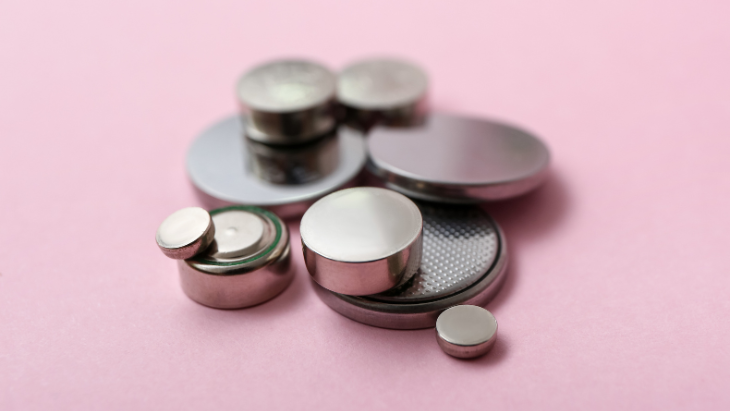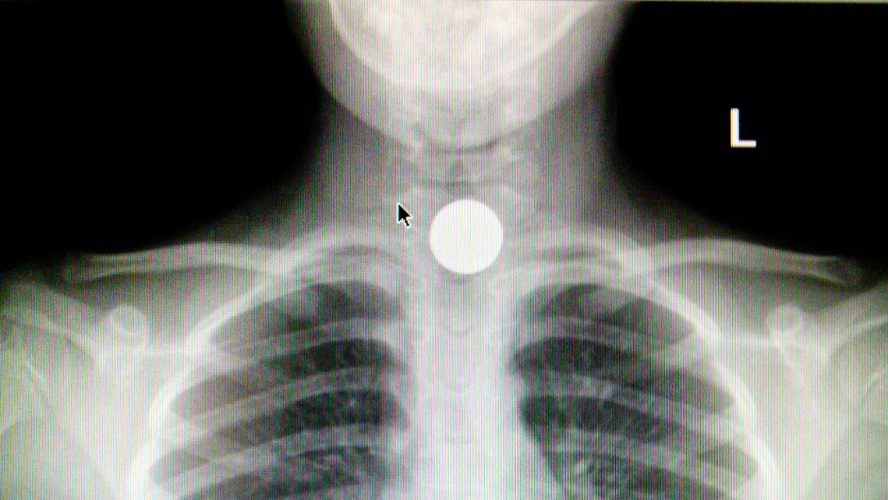
Small, smooth and shiny, button batteries can be tempting to children.
If you have or care for children and you haven’t heard of button batteries, they’re definitely something that should be on your radar.
Button batteries, or coin batteries, are small and very powerful. They are used to charge up devices that have a longer shelf-life, like watches, thermometers, kitchen scales and car keys.
Unfortunately, button batteries can look very attractive to children, like lollies or coins. Even when button batteries are used and ready to be thrown away, if a child swallows or inserts one into their body, they can cause severe injuries or death.
Around 20 children a week are rushed to emergency departments across Australia because they have swallowed or inserted a button battery. But despite the health risks for young kids, button batteries are still used because they are a consistent and reliable source of power for portable electronics.
We’ll help you understand the danger of button batteries, the types of devices they’re found in, and what to do if your child swallows a button battery.
Why are button batteries a health risk?
Button batteries are bright and shiny which makes them very attractive to young children, and they can produce a small fizz if placed on the tongue.
Button batteries can be dangerous for a number of reasons. They pose a serious choking hazard because they are small, round and flat, making them easy for kids to put in their mouths and accidently swallow. Their size also makes it easy to poke into an ear or nose. Button batteries, even flat ones, can cause serious internal burns when lodged in the body.
Button batteries can lead to serious internal burns in as little as two hours. If a battery is swallowed, it can get stuck in the digestive system, causing internal bleeding, and can lead to death.
How do button batteries cause internal burns?
When a button battery gets wet – like from saliva if it’s been swallowed – it causes the electrical current in the battery to become corrosive. This means it can burn a hole through parts of the digestive system, such as the oesophagus (the tube that connects your mouth to your stomach), the stomach or the bowel. Even if the battery is used and ready to be thrown away, it still produces enough electricity to cause burns inside the body.
Watch what happens when a button battery is inserted into a chicken breast – the same thing happens to the inside of a child’s body if they swallow a button battery and it gets stuck in their system.
What products use button batteries?
Button batteries are generally used in portable devices you’d find around the home. If a product is small, electronic and not rechargeable, it probably runs off a button battery. These products can include:
- watches
- remote controls
- car keys
- children’s toys
- bathroom and kitchen scales
- musical greeting cards
- books with music or sound effects
- hearing aids
- reading lights
- cameras
- calculators
- thermometers
- light up shoes (batteries can fall out if soles are worn down)
- wearable or handheld light-up devices, like bracelets provided concerts.
Are button batteries a risk at home only?
Button batteries pose a risk to children in any environment. Be mindful of button batteries in places where children play like childcare centres, creche facilities at gyms or shops, or libraries. Be aware of products that might use button batteries and stored batteries when visiting other people’s homes.

How can I prevent my child swallowing a button battery?
Only buy safe products
If you’re buying a product that uses button batteries, the battery compartment should be child-proof. This means it either requires a tool such as screwdriver to open it, or it needs two movements to open it, such as pressing a button and sliding back the compartment at the same time. Only buy robust products where the battery can’t come loose if the item is dropped or broken apart.
Mandatory standards are enforced Australia-wide for products containing button batteries and the packaging button batteries are sold in. You can report products that use unsecured button batteries to the Queensland Consumer Product Safety Unit or the Australian Competition and Consumer Commission (ACCC).
Find a list of recalled button battery products from Product Safety Australia.
Dispose of used button batteries immediately
It is very important to properly throw away flat button batteries, because they can still produce enough charge to cause burns when lodged inside the body. Tape button batteries on both sides with sticky tape as they come out of the product, which makes them tricky to swallow and reduces fire risks. Dispose of them immediately.
If you are recycling your batteries, keep them in a secure container well out of reach of children.
Store button batteries safely
Button batteries must be sold in child-proof packaging, which means it needs scissors to open. Store unused button batteries in their packaging up high, out of the reach of children, preferably in a locked cupboard or container, like you would poisonous products or medicines.
Watch your child if they’re playing with a toy that uses button batteries
It can be hard to know if your child has swallowed a button battery if you didn’t see it, and the soft tissue in the oesophagus and gut doesn't register pain very well, so the battery can burn severely without the child noticing. If your child has toys you know contain button batteries, make sure they only play with them when you are watching.
Tell others of the danger
Word of mouth is a powerful tool among friends and family, so share this important information as often as possible, and help other parents and carers understand the danger of button batteries. Ensure the people in your life who buy toys for your children, or babysit your kids, are also aware of the dangers.
What to do if my child swallows a button battery?
It can take as little as two hours to cause severe burns once a button battery has been ingested and remains lodged in the body, so you need to act quickly.
Your child may show the following symptoms if they have swallowed a button battery:
- gagging or choking
- drooling
- chest pain (sometimes this causes the child to grunt)
- coughing or noisy breathing
- unexplained vomiting or food refusal
- black or red vomits or bowel motions, which can indicate bleeding from the gut
- nose bleeds
- unexplained fever.
If you suspect your child has swallowed a button battery, contact the Poisons Information Centre immediately on 13 11 26. If you’re not able to do that, go straight to a hospital emergency department. Do not let the child eat or drink, and do not try and make them vomit.
Other choking hazards and dangerous items found around the home
Anything smaller than a D size battery (that’s the large round one) or a 20-cent piece can be a choking hazard for young children. Things like beads, marbles, eyes off soft toys, coins, jewellery, and paper clips should be kept out of reach of children at all times.
The ACCC has created a downloadable ‘choke check’ tool, which parents can print out to see if an object is a choking hazard. If it can fit through the tool, it’s something a child can choke on. You can download the Choke Check tool here.
Other batteries, especially lithium batteries, and fridge magnets pose a similar danger to button batteries when swallowed. If a child swallows more than one magnet, they can stick together in the digestive tract, causing blockages and even holes in the wall of the gut.
What do I do if my child is choking?
Raising Children has instructions on providing first aid for choking infants and children, with pictures demonstrating each step. You can also download and print choking first aid guides for babies, children and adults from St John Ambulance Australia, to stick up somewhere handy like on the fridge.
If you think a young child is choking, call Triple Zero (000) for an ambulance, and stay on the phone with the operator while following the first aid steps. If an older child is choking, encourage them to cough to see if it dislodges the object. If it doesn’t, follow the first aid steps, calling for an ambulance if choking continues.
There’s no substitute for learning in-person first aid. Parents and carers can access first aid training through a number of providers, including Queensland Ambulance Service, St John Ambulance, Australian Red Cross, First Aid Academy and other private providers.